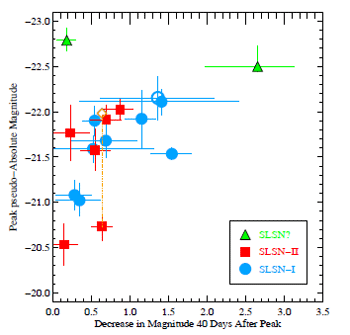How often do stars explode as exceptionally bright supernovae?

It is not yet clear what gives rise to supernovae with a peak brightness many times the average, so-called superluminous supernovae (SLSNe), but since they are observable from further away than normal supernovae, a better understanding of these events might also make them a valuable additional 'standard candle' for distance measurements in the Universe. Using survey data from the ROTSE-IIIb telescope at the McDonald Observatory (Texas, US) that covered 500 square degrees of sky, a small team of international researchers – including CAASTRO member Dr Fang Yuan (ANU) – has now calculated the volumetric rate of SLSNe.
Having identified five suitable events, the first step in their calculations was to produce light curve templates and estimate pseudo-absolute magnitude distributions for both hydrogen-poor SLSN Type I and hydrogen-rich SLSN Type II. Monte Carlo simulations were then used to determine the efficiency of different surveys on the telescope in 'shortlisting' candidates in a given volume of sky. For the pooled SLSN-like data and at a redshift of 0.2 (local volume), the team calculated a volumetric rate of 199 events Gpc-3 yr-1 h3 which, due to the small sample size, is subject to large statistical (199 +137 / -86) and systematic (199 +65 / -41) errors.
Their results approximately match the local rate of sub-energetic, long-duration gamma-ray bursts but are exceeded by the estimated rate of core collapse supernovae by a factor of 400 to 1300. These new calculations now offer an opportunity to determine the origin of SLSNe by comparing them with the formation rate of stars in the critical mass range at similar redshifts. And since peak magnitudes of SLSN Type I were found to be tightly clustered (M = -21.7 ±0.4), these events might be a promising 'standard candle' once sufficient sample sizes have been reached.
More information: Quimby, R. et al. Wheeler in MNRAS 431 "Rates of Superluminous Supernovae at z ~ 0.2" arxiv.org/abs/1302.0911
Provided by CAASTRO





















